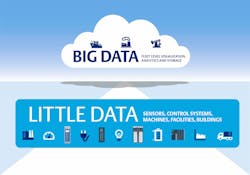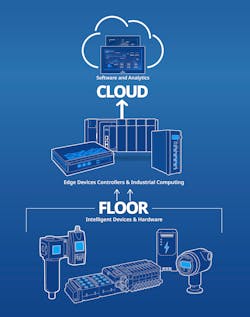Digital Transformation: Guidelines for CPG Industry Implementations
At a Glance:
- The author identifies some benefits of the iterative process behind digital transformation.
- Guidelines are provided for defining the problem, as well as a rationale for quantifying expected value.
- Two case studies demonstrate the results of successful CPG industry implementations.
A typical consumer packaged goods (CPG) manufacturer operates many types of equipment, sometimes spanning multiple production lines and facilities. Functionally integrating such a wide range of processing and packaging equipment—often acquired over many years from various original equipment manufacturers (OEMs)—and running it as an integrated whole is a significant challenge.
Truly optimizing all aspects of these assets has remained just beyond the grasp of many companies. This is largely due to the difficulty of obtaining and analyzing data sourced from such a multitude of different assets to create actionable insights.
To address this and related issues, the term “digital transformation” is often used to describe new means and methods of connecting smart technologies to provide users with operational visibility and enhanced abilities to optimize manufacturing operations. Technologies have become available to outfit both new and legacy systems with a seamless and transparent Floor to Cloud architecture.
Smart field instrumentation, digital equipment controllers and Industrial Internet of Things (IIoT) devices of all types can now be seamlessly integrated, and then connected with higher-level computing systems.
Understanding the most effective ways to carry out digital transformation is important to end users, OEMs and systems integrators (SIs) alike.
The Digital Transformation Journey
Depending on the industry and application, the desire to optimize efficiency can mean many things. Increasing throughput, reducing energy use, ensuring quality, minimizing downtime, improving sustainability, supporting problem solving, avoiding waste and enhancing safety are just some of the important goals. Each of these benefits can be realized if the problem can be defined, conditions measured, data analyzed and insights obtained to prompt corrective action.
READ MORE: Digital Transformation, Beyond the Buzz
Knowing how and where to begin can be difficult, especially for a first-time attempt. Indeed, many large digital transformation undertakings have failed to deliver value, often because they were overly ambitious. Understanding two important factors can help guide the effort to avoid this issue:
- Digital transformation is a journey, often an iterative process and never fully achieved after just one project.
- Effective projects usually start small with defined business cases, with momentum built by achieving successes delivering quantifiable, which can then be scaled up.
Multiple hardware, software and communications technologies must be deployed to transport field-sourced little data from a variety of sources to higher-level computing resources so that the aggregated big data can be analyzed and acted upon. Little data generally originates from edge-located operational technology (OT) assets. Big data computing is usually carried out using on-premises or cloud-based information technology (IT) computing resources.
As digital transformation within an organization evolves and progresses, each step forward may also expose other lesser issues, which can likewise be addressed. When embarking on a digital transformation project, answering certain questions will provide some additional clarity.
- What problem is being solved? Clearly identifying specific constraints, pain points and areas needing improvement is required.
- Why does it need solving, and is it worth solving? Defining the value of success, as well as the cost of doing nothing, establishes whether digital transformation will be cost-effective for each project.
- Who is affected? Success typically requires buy in from many stakeholders—both internal (engineering, maintenance, operations, sales) and external (end customers, distributors)—each of whom see the benefit of solving the problem.
- Where is the information needed to solve the problem? Gathering the right information is foundational to addressing the preceding questions.
Breaking a problem down into smaller achievable pieces, clearly defining it, quantifying the expected value and involving all those who can help or receive benefit are keys to success. Some of the necessary information to support these efforts may already be available, but additional information is often needed to prove project feasibility.
Connecting with Stranded Data
When it comes to evaluating an organization’s ability to incorporate digital transformation, it is important to assess the people, data and technology involved. Are personnel implementors or users available, and how comfortable are they working with technology and data? Is the required data completely siloed, or are there some existing systems in place to aggregate data? And where is the company on the spectrum of automation maturity?
READ MORE: A Successful Digital Transformation Hinges on Values
The latter point—automation maturity—refers to a range of technical capabilities that currently apply to the company. Each part of the operation exists as:
- Manual operations
- Island of automation
- Connected automation
- Enhanced connectivity and analysis
- Insight-driven operations
An organization lower in the automation maturity range will tend to have more data stranded in isolated, ignored, under-sampled, inaccessible or non-digitalized formats. And that organization will have correspondingly greater challenges accessing this stranded data.
Start Small, and Scale Up on Successes
With all these considerations in mind, a digital transformation team is ready to tackle their first projects. They can gather existing information and create a high-level roadmap. Starting small with a contained scope will help to achieve buy-in from stakeholders and increase the prospect of quantifiable success. Small successes can be improved upon and deployed more widely to scale up into large gains.
Part of the planning involves selecting a proven automation and information hardware/software platform. This will enable the team to focus more on solving business problems, and less on time-consuming implementation details.
Digital transformation teams are best served by choosing a platform built on recognized and proven industry standards and interoperable with both OT and IT needs to provide seamless Floor to Cloud integration. The platform should use the latest technologies, especially with regards to cybersecurity, and it should also interface well with the many legacy systems which will likely be involved.
A complete digital transformation platform will have products for field devices, such as sensors, actuators, motor controls and more. It will offer computing options for gateways, PLCs/PACs, edge controllers, operator interfaces and industrial PCs. Software and development environments will be consistent and interconnected for control logic, HMI/SCADA, data servers, edge computing and connectivity, and analytics for efficiency and energy management.
There can be a preference for digital transformation projects to use a variety of vendors. However, the nature of the work and greater network/internet connectivity introduces cybersecurity risks which are difficult to anticipate and test for with custom designs, and which can’t be fully addressed by added on measures. Cybersecurity must be built-in throughout the platform, using proven secure-by-design and defense-in-depth measures, which is more easily implemented by using product and solutions from a single vendor.
Digital Transformation Case Studies
The following case studies illustrate how companies are progressively and effectively implementing digital transformation.
Case Study 1: Enhanced Services
An OEM serving the CPG industry with palletizing and material handling machines had already successfully automated their equipment with PLCs, HMIs, AC drives, pneumatics and sensors. Revising these core designs to add enhanced connectivity and analytics would require significant design changes. However, by specifying an analytical edge solution based on an industrial PC and ready-to-configure software, they were able to add a complete asset health monitoring solution to their standard offerings as an option, without impacting the underlying automation design.
This platform incorporates a data historian and web-capable visualization, so credentialed users can securely view information, from wherever they are located, for the asset and subcomponents. The OEM added value for their clients and remote connectivity improved their visibility into the equipment for predictive maintenance and their ability to serve their customers better with ongoing support contracts. Digital transformation for this OEM enabled them to preserve existing automation investments, while quickly delivering a requested and valuable option for their customers.
Case Study 2: Embracing Digital Transformation
Another CPG company operates in the food & beverage industry as a packaging contractor—receiving bulk products such as soup, milk and sports drinks—and then packing them into various containers and preparing them for shipment. Production was driven by enterprise resource planning (ERP) requirements, but the operation was completely manual, with printed instructions sent to the shop floor. All setup directions and subsequent tracking were performed by hand, introducing delays and errors.
The company wanted better visibility but was not in a position to deploy a massive manufacturing execution system (MES). Instead, they progressively implemented a scalable solution to initially collect data from existing sources, such as good/bad product counts through the production line. Later, they enhanced the system to digitally transmit work instructions to the floor, and to incorporate barcodes and scanners. A live dashboard delivered productivity, overall equipment effectiveness (OEE) and downtime metrics, while reports more effectively communicated production results and issues.
Digital transformation helped this company solve one problem at a time in a practical manner so they could centralize information, speed up response times and progressively improve operations. They began with visibility, then evolved the solution into a tool for increasing efficiency.
A Roadmap for Digital Transformation
The digital transformation journey is different for each organization, with significant variations among end-user operating companies, OEMs and SIs. But by asking the right questions and then effectively creating a high-level roadmap supported by the answers, digital transformation teams can develop clarity surrounding the goals, costs and expected value of these projects. They can then find great benefit as they achieve small successes early through proof-of-concept efforts and then scale them up into larger wins.
READ MORE: Digital Transformation: The CEO of the Future is a Technologist, Not an MBA
A progressive strategy will begin with connecting smart technologies to access valuable field data and provide visibility to users, leading to analytics that will empower users to perform their jobs more easily and effectively by leveraging technology and data. Whatever the automation maturity level of an organization, implementers are best served by selecting and building their solutions on a comprehensive digital transformation platform.
The platform needs to incorporate field devices, computing hardware and control/visualization/edge software, with an emphasis on connectivity and security. By choosing a proven platform developed and supported by a leader in the industrial automation and computing field, developers are freed to focus their efforts on optimizing operations.
Silvia Gonzalez is the director of product management, SCADA/HMI, for the Emerson Controls & Software business. Gonzalez is responsible for developing IIoT and industrial automation technologies that bring increased value to customer operations. She holds a bachelor’s degree in electrical/electronic engineering from Universidad La Salle, Mexico, and she has received a digital business strategy certification from MIT.
About the Author
Silvia Gonzalez
Solutions Development Leader, Machine Automation Solutions Business, Emerson
Silvia Gonzalez is a solutions development leader for Emerson's Machine Automation Solutions business. She is responsible for creating, developing and driving solutions-oriented approaches for translating end-user challenges into improved operational performance.



